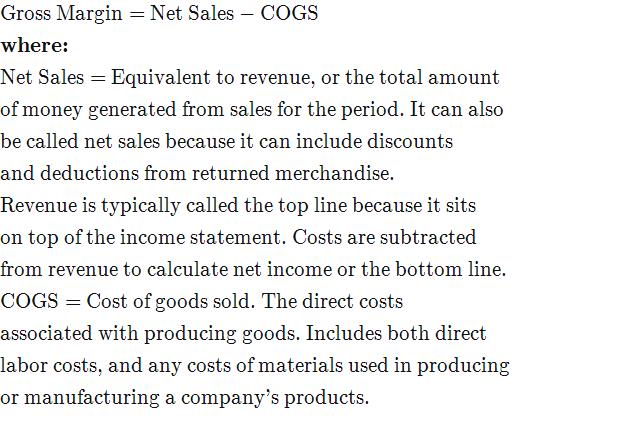Definiția marjei brute
Ce este marja brută?
Marja brută este venitul net din vânzări al unei companii minus costul bunurilor vândute (COGS). Cu alte cuvinte, este veniturile din vânzări pe care le reține o companie după ce suportă costurile directe asociate cu producerea bunurilor pe care le vinde și serviciile pe care le furnizează. Cu cât este mai mare marja brută, cu atât mai mult capital reține o companie pentru fiecare dolar de vânzări, pe care îl poate folosi apoi pentru a plăti alte costuri sau pentru a îndeplini obligațiile datoriei. Cifra vânzărilor nete este pur și simplu venituri brute, mai puțin randamentele, cotele și reducerile.
Formula pentru marja brută este

How to Calculate Gross Margin
To illustrate an example of a gross margin calculation, imagine that a business collects $200,000 in sales revenue. Let us assume that the cost of goods consists of the $20,000 it spends on manufacturing supplies, plus the $80,000 it pays in labor costs. Therefore, after subtracting its COGS, the company boasts $100,000 gross margin.
What Does the Gross Margin Tell You?
The gross margin represents the portion of each dollar of revenue that the company retains as gross profit. For example, if a company’s recent quarterly gross margin is 35%, that means it retains $0.35 from each dollar of revenue generated. Because COGS have already been taken into account, those remaining funds may consequently be channeled toward paying debts, general and administrative expenses, interest fees, and dividend distributions to shareholders.
Companies use gross margin to measure how their production costs relate to their revenues. For example, if a company’s gross margin is falling, it may strive to slash labor costs or source cheaper suppliers of materials. Alternatively, it may decide to increase prices, as a revenue increasing measure. Gross profit margins can also be used to measure company efficiency or to compare two companies of different market capitalizations.
Key Takeaways
- Gross margin equates to net sales minus the cost of goods sold.
- The gross profit margin shows the amount of profit made before deducting selling, general, and administrative costs.
- Gross margin can also be shown as gross profit as a percent of net sales.
The Difference Between Gross Margin and Net Margin
While gross margin focuses solely on the relationship between revenue and COGS, the net profit margin takes all of a business’s expenses into account. When calculating net profit margins, businesses subtract their COGS, as well as ancillary expenses such as product distribution, sales rep wages, miscellaneous operating expenses, and taxes.
Gross margin–also called „gross profit margin”, helps a company assess the profitability of its manufacturing activities, while net profit margin helps the company assess its overall profitability.
For related insight, read more about corporate profit margins.